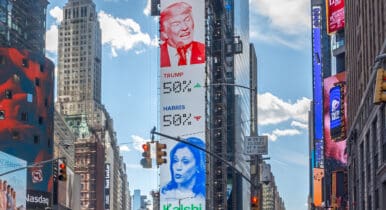Why Your Campaign Needs a Brand Guide

After graduating from the University of Maryland, Taí Coates-Wedde expected to grow a career in brand marketing and advertising. But after she crossed paths at Burson-Marsteller’s DC office with some political practitioners who became mentors, including Luke Peterson, Josh McConaha, Collin Berglund and Courtney Sieloff, she began pursuing a creative career in the campaign industry.
Over the last two years, she’s been at Woolf Strategy where she’s now Director of Client Management. Part of her expertise is in branding, having helped not just political clients with the process, but also the firm itself.
About 10 months ago, Asana Creative Strategy rebranded as Woolf Strategy, a process that was led by the firm’s internal team.
C&E: You’re an advocate for campaigns creating branding and style guides, how come?
Coates-Wedde: They’re helpful for a lot of reasons. I think that the biggest thing that you get out of it is consistency. You’re bringing in so many different vendors when you’re running a campaign. You have digital folks, you have people who are handling all of your press. You might have somebody who’s specifically working on comms and other people who are specifically working on social media. So when you have so many cooks in the kitchen, it’s really important to have a standard that allows for consistency. That way the brand looks the same, and that is how you build up brand recognition. That’s how you build up name recognition. And it makes it easier for people to recognize the different candidates who are out there, especially if they put time and effort into having a recognizable look and feel.
C&E: What about a creative brief, is that the same as a style guide or a brand guide?
Coates-Wedde: A creative brief is a specifically internal document that helps ensure that we, the vendors, are on the same page as our client when it comes to their visual and messaging goals and dreams for the overall campaign. The creative brief takes all of the initial conversations that we’ve had with the client about what they’re hoping for in their strategy, their messaging, and it applies our insight and strategy to that. So the difference between that and a brand guide or a style guide is that 1) This happens at the beginning of the process. This is usually part of the discovery process when you’re onboarding a client. And then 2) Your brand guide and your style guide comes after you’ve determined everything. So the creative brief is actually your map for you to be able to create the style guide and the brand guide.
C&E: Does that work in a rush situation?
Coates-Wedde: We all have rush clients. And so ideally it would be nice to have a whole bunch of lead time, but if we don’t, we would usually do our kickoff call, send them a questionnaire, tell them to have a look at it, and then turn it back over to us in a week. And then we’ll start working together and just kind of treat the discovery process as a month for faster clients so that way you’re not answering so many questions and it’s not consuming as much time. But I still think that it’s important to do it, whether it’s abbreviated or not.
C&E: Do these documents also help hold clients accountable?
Coates-Wedde: I would love to brainstorm on projects forever, but at the end of the day, we gotta get moving. That’s what the creative brief is for: to make sure that we absolutely know what course we’re [on]. It just stops you from being all over the map and it helps to center everything as well.
C&E: Talk about the importance of getting through the creative and branding pieces of this up front rather than on the fly.
Coates-Wedde: If you’re catching them at the beginning of your time with them, that’s when they’re the most excited about their campaign. So doing a creative brief not only helps you save time and money, but it helps you capture your client at their most authentic time. You just start thinking about all the possibilities and that passion is what helps create a really good [brand for a] campaign. Things get lost in the sauce as time goes by.
C&E: As creative becomes more standardized in the campaign industry, can you see candidates doing rebrands or relaunches when they’re, say, trailing in a race?
Coates-Wedde: You’ll probably see more brand refreshes, which is not a complete overhaul of an existing brand, just something that makes it look new, but still similar. Like there are some really outdated logos and websites out there. And so getting that done as quickly as possible might actually [help] the client. But for a more static client, like if I were doing a logo rebrand or a website redesign, for example, that is more of a static thing where you would really deviate.



